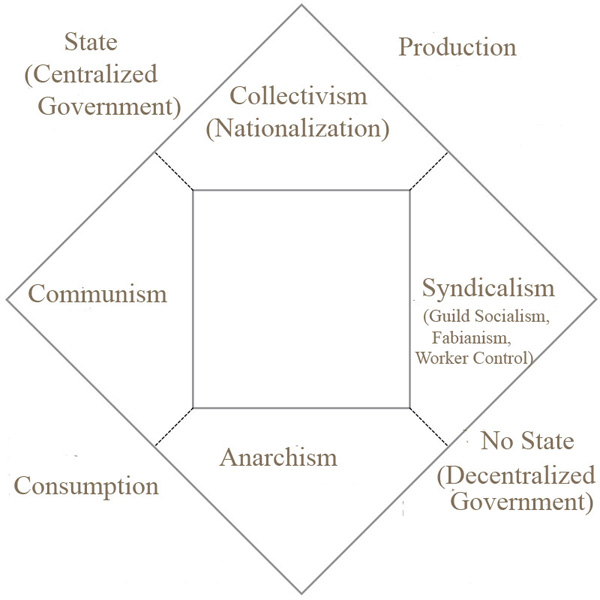First, concerning the definition of “socialism,” Gray is all over the place talking about individualism, communism, justice, efficiency, equality — finally settling for an unsystematic classification of socialisms rather than for a definition. And even the classification is done on the basis of secondary matters.
Anton Menger, by contrast, at the very beginning of his book, sets up as his desiderata (criteria) for socialism three disjunctive conditions. By “disjunctive” I mean that any one of them singly is sufficient for socialism. And it is left as an open question whether the three are jointly compatible. The three are:
- Right to the whole produce of labor
- Right to subsistence
- Right to labor
He quickly notes that the third is a species of the second. In other words, that labor is a way of getting subsistence.
In chapters 2-12 he goes over the literature on how these desiderata were treated, mostly the first. He spends much time considering how communities or associations were to be organized. This applies to colonies, as well as to domestic organizations. And in the last chapter 13, he offers possible solutions through a consideration of land ownership, which he lists as three possibilities:
- Private ownership and private use
- Common ownership and private use
- Common ownership and common use
Let me point out that this classification assumes that land is a sellable commodity, and that it can be owned either by individuals or groups. It does not include the possibility that land is not owned.
All three alternatives can exist in present States. It is simply which is preferable. The first alternative is what prevails in the world, dominated by private corporations. The existing laws allow private ownership, and the hiring of people for private production and private profit (or for whatever the owners wish).
He cites the Russian village (Mir) as an example of common ownership, and private use (the second alternative). Actually the Russian village did not “own” the land; it collectively managed the land, and through periodic democratic assemblies divided the arable land in some agreed to plots.
Proposals to nationalize the land are variations on this second alternative.
The third alternative was realized by the various communal colonies — either religious or non-sectarian — which, for example, were set up in the United States. He cites the reporting of William Hinds [American Communities] for these communitarian experiments.
His conclusion is that the socialist ideal is satisfied by these last two alternatives, but not having a clear proposal for how subsistence relates to labor, he simply notes that the right to subsistence prevails in these communitarian societies; thus, satisfying one socialist desideratum.
Critical commentary:
Although I disapprove of ad hominem arguments, here I offer an ad hominem circumstancial which should guide our critical consideration of Menger’s proposals. He, as a salaried professor of jurisprudence at the University of Vienna (and wanting to keep his job), should have kept away from a criticism of the State, and he did; simply mentioning that anarchists wish to eliminate the State. He himself was interested in how to lawfully realize socialism, i.e., in and by a State. And he did have Bismark’s social legislation as a model.
My first observation is this. All primitive tribes and stateless communities satisfy all three desiderata. But this is anarchism, which is not under Menger’s purview.
My second observation is this. The Russian Mir was owned by a landlord, and all of Russia was owned by a Czar, and both required taxes from the village. The village only determined land usage and how the taxes were to be distributed among the villagers.
My third observation is that all the communitarian colonies in the United States had to purchase the land either from the State or from individuals. In some cases, these colonies did so by borrowing money, which they had to pay back with interest. And let us not forget property taxes exacted by the individual states. Thus, although all colonies became self-sufficient concerning subsistence, they were forced to enter an outside market economy to repay their debts.
Strictly speaking, the first — and main — ideal of socialism cannot be fully realized by any of these alternative property holdings, as long as there is a State which takes taxes.
The other consideration, pointed out by Menger, is that the communitarian colonies — taken as individuals — were in competition with other corporations and individuals for a market. And success was not guaranteed. [This criticism applies to Richard Wolff’s proposal for worker-owned enterprises. And it does not solve the problem of unemployment and homelessness.]
Although I am interested in what these communitarians believed and how they managed their affairs, I am more focused on the fact that they had to purchase their land holdings, and that they had to pay property taxes.
I think there is a preconception in people’s mind about the vast amount of land which was open to settlement in “the frontier.” Well, let’s be clear, in areas where either a British colony, or eventually a State made a survey and gained control, i.e., jurisdiction, no land was available for free. Yes, those who ventured into the frontier beyond government control could eke out a living by hunting and gathering, and even by building a homestead, i.e., by squatting. But beside the danger of encroaching on Indian territory, as soon as the government reached their territory, these squatters had to pay for the land through what were called “preemption laws.” This means that they had the first right to buy the land. If they could not, they were evicted.
I found the book by Roy M. Robbins, Our Landed Heritage: The Public Domain 1776-1936, an eye opener. This book should be read in conjunction with Richard Morris, Government and Labor in Early America.
All land was the property of the State, and in May 20, 1785 (modified in 1787) a law was established that land was to be surveyed into Townships, an area of 6 x 6 miles, divided into 36 “sections” of 1 x 1 mile (640 acres). [As an aside. Under the Homestead Act of 1862, pioneers were granted 1/4 section (160 acres) (for a small processing fee and a condition that the land be “improved” within 5 years), and in 1865 General Sherman proposed to give 40 acres to former slaves — a proposal which was rescinded by President Johnson]
Land was to be sold at auction with a minimum of $1 per acre, and a $36 fee for the surveyed Township. (I have not determined what was the minimal acres which were sold, but apparently speculators gobbled up the land in huge chunks, which they then sold at retail inflated prices. And there were shady acquisitions galore.
My point is that prior to 1862 there never was land to be taken legally for free.
Next, let me make some other observations. Menger says that the first desideratum has implications of a negative sort. He claims that it implies that no one is allowed to rent out land, and that there is to be no interest taken on loans. I am not sure how universal he means to make these prescriptions. Given that farmers and manufacturers had to purchase land and machinery, there were various proposed schemes to set up Banks and Credit Unions which would take only a minimal interest to offset the cost of processing a loan.
I want to end with the following observation as found in Franz Oppenheimer’s book, The State:
“For as long as man has ample opportunity to take up unoccupied land, “no one,” says Turgot, “would think of entering the service of another;” we may add, “at least for wages, which are not apt to be higher than the earnings of an independent peasant working an unmortgaged and sufficiently large property;” while mortgaging is not possible as long as land is yet free for the working or taking, as free as air and water.” p. 9-10

